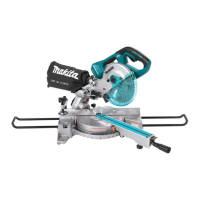25 ENGLISH
Cutting repetitive lengths
CAUTION: For the tool equipped with the hold-
ers and the holder assemblies as standard acces-
sories, this type of use is not permitted due to the
country regulations.
When cutting several pieces of stock to the same
length, ranging from 220 mm to 385 mm, use the set
plate (optional accessory). Install the set plate on the
Fig.52: 1. Set plate 2. Holder 3. Screw
Align the cutting line on your workpiece with either the left or
right side of the groove in the kerf board, and while holding
the workpiece. Then secure the set plate with the screw.
When the set plate is not used, loosen the screw and
turn the set plate out of the way.
NOTE: Use of the holder-rod assembly (optional
accessory) allows cutting repetitive lengths up to
2,200 mm approximately.
Groove cutting
WARNING: Do not attempt to perform this
type of cut by using a wider type blade or dado
blade. Attempting to make a groove cut with a wider
blade or dado blade could lead to unexpected cutting
results and kickback which may result in serious
WARNING: Be sure to return the stopper arm
to the original position when performing other
than groove cutting. Attempting to make cuts with
the stopper arm in the incorrect position could lead to
unexpected cutting results and kickback which may
For a dado type cut, perform as follows:
1.
limit the cutting depth of the circular saw blade. Refer to
the section for stopper arm.
2. -
lar saw blade, cut parallel grooves across the width of
the workpiece using a slide (push) cut.
Fig.53: 1. Cut grooves with blade
3. Remove the workpiece material between the
grooves with a chisel.
Carrying tool
WARNING: Stopper pin is only for carrying
and storage purposes and should never be used
for any cutting operations. The use of the stopper
pin for cutting operations may cause unexpected
movement of the saw blade resulting in kickback and
CAUTION: Always secure all moving portions
before carrying the tool. If portions of the tool move
or slide while being carried loss of control or balance
Fig.54
1. Remove the battery cartridge.
2. Secure the blade at 0° bevel angle and the turn
base at the full right miter angle position.
3. Secure the slide poles so that the lower slide pole
is locked in the position of the carriage fully pulled to
operator and the upper poles are locked in the position
of the carriage fully pushed forward to the guide fence.
4. Lower the handle fully and lock it in the lowered
position by pushing in the stopper pin.
5.
Carry the tool by holding both sides of the tool base. If you
remove the holders, dust bag, etc., you can carry the tool more easily.
MAINTENANCE
WARNING: Always be sure that the blade is
sharp and clean for the best and safest perfor-
mance. Attempting a cut with a dull and /or dirty blade
may cause kickback and result in a serious personal
CAUTION: Always be sure that the tool is
before attempting to perform inspection or
maintenance.
NOTICE: Never use gasoline, benzine, thinner,
alcohol or the like. Discoloration, deformation or
cracks may result.
Adjusting the cutting angle
your tool is not aligned properly, perform the following:
Miter angle
1. Push the carriage toward the guide fence and
tighten two clamp screws to secure the carriage.
2. Rotate the turn base until the pointer indicates 0°
on the miter scale.
3. Rotate the turn base slightly clockwise and coun-
terclockwise to seat the turn base in the 0° miter notch.
(Leave as it is if the pointer does not indicate 0°.)
4. Loosen the hex socket bolts securing the guide
fence using the hex wrench.
Fig.55: 1. Guide fence 2. Hex socket bolt
5. Lower the handle fully and lock it in the lowered
position by pushing in the stopper pin.
6. -
ular angle with the blade using a triangular rule, try-
square, etc. Then securely tighten the hex socket bolts
on the guide fence in order starting from the right side.
Fig.56: 1. Triangular rule 2. Guide fence
7.
Make sure that the pointer indicates 0° on the miter scale.
If the pointer does not indicate 0°, loosen the screw which
Fig.57: 1. Screw 2. Miter scale 3. Pointer

